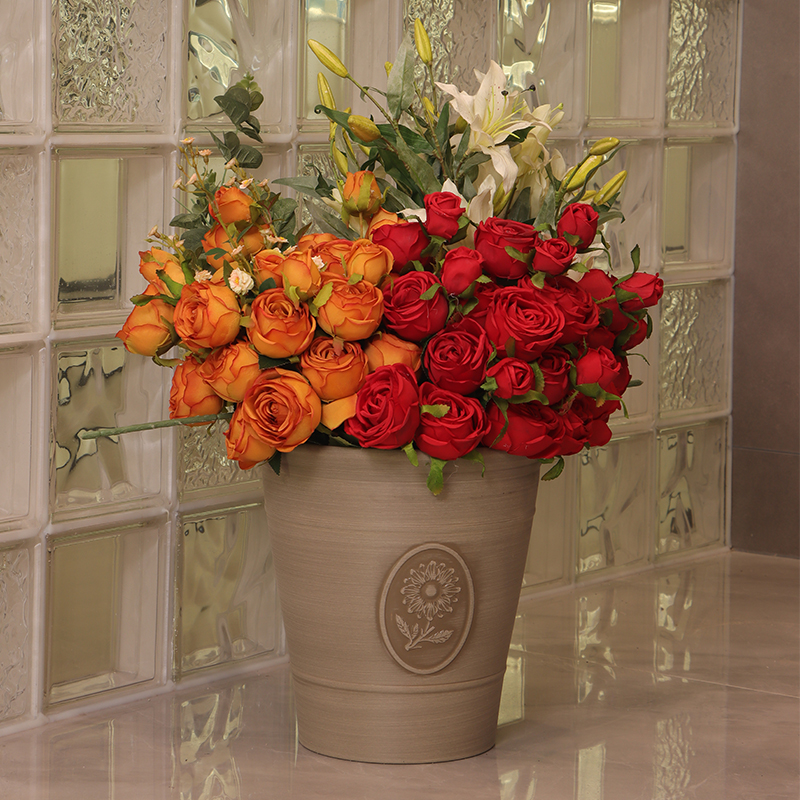In today’s global gardening market, export-grade flower pots must meet several important requirements to ensure they perform well across different climates, satisfy diverse consumer needs, and comply with international standards. Whether the shipment includes plastic coloured plant pots, rattan plastic plant pots, or painted flower planters, manufacturers and exporters need to understand what qualities and specifications are essential for successful export.

One of the main considerations for export-grade flower pots is durability. These products often travel long distances and are subjected to multiple handling stages, so resistance to cracks, chips, or breaks is crucial. Plastic coloured plant pots, for example, are popular for their lightweight nature and resistance to shattering compared to ceramic or clay alternatives. However, not all plastic pots are created equally. Export-grade plastic coloured plant pots must be made from quality polymers that withstand UV exposure, temperature variations, and rough handling without degrading.
Similarly, rattan plastic plant pots have grown in popularity because they combine the aesthetics of natural rattan with the practical benefits of plastic. For these pots to qualify as export-grade, their structure needs to retain flexibility without cracking and maintain the woven texture through shipping and everyday use. The rattan plastic plant pots should also resist fading and maintain their look over time, which requires selecting suitable plastic materials and using UV stabilizers during production.
Painted flower planters add another layer of complexity to export requirements. The paint or coating on these pots must adhere strongly to the base material to avoid peeling or chipping during transit and use. Export-grade painted flower planters typically undergo testing to verify the paint’s durability against moisture, temperature changes, and abrasion. Whether the planters are made of plastic, ceramic, or metal, the painted surface quality plays a significant role in consumer satisfaction and overall product longevity.
Besides durability, functional design features are also essential. More export markets expect flower pots to include proper drainage systems to prevent waterlogging, which can harm plants. Plastic coloured plant pots often incorporate drainage holes and sometimes built-in saucers, making them convenient for indoor and outdoor use. Rattan plastic plant pots should have sufficient drainage and be designed to avoid water pooling within the woven structure, which can cause mold or unpleasant odors.
Painted flower planters, depending on their material, might require additional waterproofing or sealing on the painted surface to ensure longevity in wet conditions. Export-grade painted flower planters often comply with certain quality certifications that confirm the product’s safety and suitability for home gardening environments. Such certifications vary by region but typically include chemical safety standards and eco-friendliness, especially when the products are intended for residential use.
Another key requirement for export-grade flower pots is consistent sizing and packaging. Buyers from different countries prefer uniform pot sizes for easy stocking and compatibility with standard gardening accessories. Plastic coloured plant pots are often produced in various standard sizes, but exporters must ensure that the dimensions are consistent from batch to batch to meet buyer expectations. Rattan plastic plant pots and painted flower planters also follow this practice, especially when the products are sold in sets or collections.
Packaging for export is designed not only to protect the pots but also to optimize shipping costs and facilitate handling. Exporters of plastic coloured plant pots, rattan plastic plant pots, and painted flower planters use packaging solutions such as shrink wrap, cardboard dividers, or stacked pallets to less damage during transport. Proper labeling and documentation are also necessary, including details like material composition, care instructions, and compliance certificates.
Environmental regulations and sustainability concerns increasingly influence export requirements. Many importers prefer flower pots that comply with eco-friendly manufacturing practices and materials. Plastic coloured plant pots made from recyclable or recycled materials meet some of these demands, while rattan plastic plant pots offer an alternative that mimics natural textures but remains recyclable. Painted flower planters may face stricter scrutiny depending on the type of paint used, especially regarding volatile organic compounds (VOCs) and heavy metals.
To summarize, export-grade flower pots must balance aesthetics, durability, functionality, and environmental considerations. Plastic coloured plant pots stand out for their variety and ease of handling, but their quality depends on raw materials and production standards. Rattan plastic plant pots provide a decorative option with a natural feel, yet they require careful material choice and construction to meet export standards. Painted flower planters attract customers with their colors and finishes, making paint quality and adhesion a critical factor.
Manufacturers and exporters who understand these common requirements can better serve international markets and maintain long-term business relationships. Focusing on consistent quality in plastic coloured plant pots, rattan plastic plant pots, and painted flower planters helps ensure the products arrive in good condition and meet consumer expectations worldwide. While challenges exist in production and compliance, meeting these standards ultimately supports growth and sustainability in the global gardening industry.

 English
English 日本語
日本語 Español
Español Deutsch
Deutsch عربى
عربى

